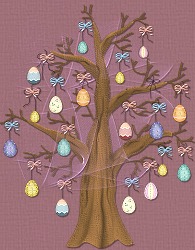|

The
History
and
Meaning
of
the
Easter
Egg

Over the centuries the egg has been seen as
the symbol of the rebirth of the earth, a sign of
fertility. The Hare/Rabbit is also a symbol of
rebirth and fertility. The bunny was first
documented as a symbol of Easter in Germany in
the 1500's, Germany also made the first edible
Easter Bunny in the 1800's.
Before the egg was associated with Christian beliefs it was used during spring
festivals as the egg gave new life the same as the season of spring brings with
it new life and a new beginning.
In pagan times people believed the egg to have
special powers some people thought it could ward off evil, whilst others thought
it would bring
them Good Luck.
The egg after Jesus' resurrection changed
to represent the beginning of new life, the
rebirth of man and not of nature as in the
earlier times. The egg was embraced by Christians and they symbolised it with
the tomb from which Christ rose.
The egg, like the rabbit was a symbol of renewal
of life so therefore represented Jesus' resurrection and the rebirth of man, and
were a logical choice as a symbol for the celebration of Easter.
The egg and the bunny are a worldwide symbol of
Easter. Although the methods and traditions can
vary greatly around the world. Whilst in Germany
and Austria green eggs are given to commemorate Christ's Last Supper, in Greece
they dye their Easter eggs red to symbolise and honour the blood of Christ.
Pisanka a batik-like decorating process using wax and dyes creates intricate,
brilliantly coloured designs on their eggs, whilst others paint them in bright
colours to celebrate spring and new life.
The most famous of the decorated Easter eggs is
the exquisite Faberge Egg made by Peter Carl Faberge. Faberge was commissioned
in 1883 by the Russian Czar, Alexander to make a special Easter gift for his
wife. This special gift made by Faberge was a platinum egg enamelled in white,
which opened to reveal a smaller gold egg, which in turn opened to reveal a gold
chicken and a jewelled replica of the Imperial crown. The Empress was so
delighted with her gift that the Czar asked Faberge to design more eggs to be
delivered every Easter. A custom which his son was to continue.
Today eggs are still painted and decorated by adults and children alike. Easter
Eggs and Rabbits as we know are also made by numerous companies around the world
and wrapped in foils of many and varied colours and patterns.
Around the world the Egg and the Rabbit, whether
they are hollow chocolate or candy, a delight to
child or a symbol of faith,they have become a
traditional part of the Celebrations of Easter.
The Hare/Rabbit was the ancient bringer of new life and renewal and now the
Easter Bunny along with the Easter Egg are symbolising the Resurrection of
Christ and the rebirth of man.

|